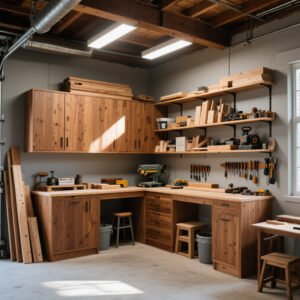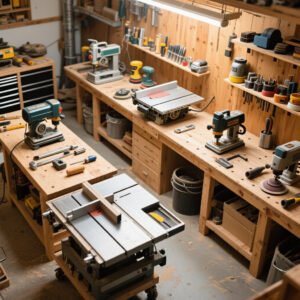| Whether you’re working in a tight garage, a spare room, or designing a full-scale professional workshop, setting up your workspace properly is absolutely essential. A well-planned setup not only boosts your productivity by keeping tools and materials organized and accessible, but also plays a critical role in ensuring your safety. From choosing the right layout and lighting to organizing tools efficiently and maintaining a clutter-free environment, every detail can make a significant difference in how smoothly and safely your projects run. |  |
📐 How to Layout a Woodworking Shop
A good layout ensures:
- Smooth workflow from cutting to assembly to finishing
- Reduced accidents and tool clutter
- Better use of space
Best layout zones:
- Cutting Station: Table saw + dust collector
- Assembly Bench: Large, stable surface + clamps
- Finishing Area: Ventilated corner for staining/sanding
- Tool Wall & Storage: Keep hand tools within reach
Start Your Projects with These Tools
- 🔗DEWALT Table Saw -$320+
- 🔗 WEN Dust Collector -$126+
- 🔗 Ted’sWoodworking Course-$67+
🧰 How to Set Up a Small Woodworking Shop
Limited on space? These tips will help:
- Use rolling basesfor heavy tools
- Choose multi-function toolsto save space
- Install folding workbenchesor wall-mountable tables
- Organize vertically with pegboards and wall racks
Beginner must-haves:
- 🔗Worx Pegasus 2-in-1 Folding Work Table & Sawhorse– $150+
- 🔗 WEN PL1252 15-Amp 12.5-Inch Two-Blade Benchtop Thickness Planer – $325+
🪛 How to Organise a Woodworking Shop
Keeping your shop clutter-free = more projects, less frustration.
Quick tips:
- Use drawer dividers and binsfor screws and accessories
- Install magnetic stripsfor tools
- Label everything (use colored tape or markers)
- Add wall-mounted shelvesfor power tools and materials
Top storage solutions:
- 🔗 TUFFIOM 8-Drawer Rolling Tool Chest – $160+
- 🔗INCLY 158PCS Metal Pegboard Wall Organizer– $75+
- 🔗 Heavy Duty Lumber Storage Rack Wall Mount – $59+
📏 What Is a Good Size for a Woodworking Shop?
The “right” size depends on what you’re making.
| Type | Suggested Size |
| Hobbyist / Beginner | 8×10 ft (tight, efficient) |
| Weekend Warrior | 10×16 ft (room for rolling stations) |
| Semi-Pro | 20×24 ft+ (full workflow zones) |
Rule of Thumb: Layout > size. A well-planned 10×10 can outperform a cluttered 20×20.
🧠 Woodshop Layout Ideas (for Any Space)
Here are three layout styles for inspiration:
🔄 U-Shaped Layout

- All tools are within a few steps
- Perfect for solo woodworkers
🔺 L-Shaped with Open Center

- Keeps middle space clear
- Ideal for small garages or corner basements
➡️ Linear/Flow Layout

- Place tools in sequence: Cut → Join → Finish
- Great for production-style workflows
Want access to over 16,000 woodworking plans?
Ted’s Woodworking gives you beginner-friendly, step-by-step blueprints to build just about anything — from furniture to Christmas décor. Check it out here »
💡 Final Advice: Buy Smart, Not Cheap
As a beginner, it’s tempting to go cheap — but good tools pay for themselves.
- Power Tools($300–$1000): table saws, routers, dust collectors
- Storage Systems($100–$500): tool chests, wall organizers, benches
- Digital Products($37–$67): woodworking plans, layout guides (ClickBank)
- Handmade Tool Organizers(Etsy): great for low-competition niches
Get Your FREE Beginner Woodshop Setup Checklist PDF!
Inside this FREE checklist, you’ll get:
- Step-by-step layout zones for maximum efficiency
- Must-have essential and power tools
- Smart storage and small-space solutions
- Recommended affiliate tools and digital resources to get started fast
